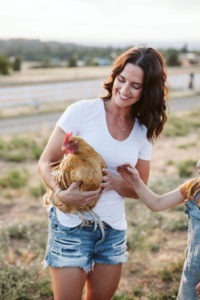
What you Need to Know Before Raising Backyard Chickens
By Katie White, Bastyr Dietetic Intern
Backyard chickens are so much fun! They’re generally easy to take care of, and one of the best
parts is you won’t have to go to the store to buy eggs. There are so many benefits to growing
your own food from the satisfaction of the work you put in to the nutritional quality of
homegrown food, and eggs are a great source of protein. Of course, chickens are a living animal
and like any pet they require proper care. Here’s what you need to know before raising backyard
chickens.
Buying Chickens (there are several options!)
If you’re up for a little extra work and don’t mind waiting for eggs, you can buy baby chicks. If
you go this route, be sure you have a brooder ready with a heat source and bedding before you
get your chicks. To buy chicks, you can order them online, at a feed store when available, or
search for a farm that sells them. Buying them from a local farm will likely be the most humane
option. Chicks can experience a lot of stress when they’re shipped and may be mishandled or
neglected. If you’re able to find a farm that sells them, you’ll be able to see how the chicks are
treated and the farmer can answer questions about raising them. If you want the full experience
of watching eggs hatch into chicks, you can buy fertilized eggs and incubate them. Hatching
eggs or raising chicks can be an exciting and educational experience, but one thing to keep in
mind is it’s likely you may end up with a rooster. Even in sexed chickens, a rooster can end up in
your flock and it will be hard to tell until they’re older. Usually you will hear a young rooster crow and then it’s most likely NOT going to give you any eggs.
If you want to start off with a flock that is already laying eggs, you can buy adult chickens and
skip the brooding box (these chickens are called “pullets”). Look for ads for chickens being sold. Sometimes chicken owners want to downsize their flock without culling their birds, so they’ll sell some of their chickens. Look out for people trying to get rid of sick or unproductive chickens and know the signs to look for a healthy vs. unhealthy hen. A healthy chicken should have a pink, well colored comb, smooth legs, clean vent (where the eggs/poop come out), and bright eyes.
Shelter
All animals need shelter, and chickens are no exception. While you may be surprised by just how
cold of temperatures a fully feathered chicken can handle, they can be sensitive to wind chill as
well as heat. Shelters are also important for keeping chickens safe from predators. A simple coop
with nesting boxes and roosts will work well for chickens. You can build this yourself or
purchase one from an animal supply store. You can also build a run along with the coop so the
chickens have a safe area for exercise and grazing. Coops come in all shapes and sizes, but the
most important things to consider when selecting or building a coop are: it must be waterproof,
wind resistant, and secure, it should be big enough for your flock (3-5 square feet per chicken),
and it should have enough ventilation. There should be at least one nesting box for every three
chickens and a few roosts. The coop should include a door that you can close at night to keep
your chickens safe from predators (there are some sneaky critters that will go into your coop and
help themselves to your chickens!). As far as cleaning, you’ll want to check the frequently used
areas like nesting boxes daily to remove any buildup of chicken poop and replace bedding if
needed. Don’t worry, depending on the size of your flock you’ll only need to do a thorough scrub down of the coop about twice a year. Other than that, just spot cleaning and replacing bedding should be plenty to keep your girls happy and healthy in their coop.
Food and Water
Just like humans, chickens have different nutrient requirements for various stages of life. You
can buy organic or non-organic feed, but there will be some basic things to keep in mind either
way. Baby chicks should be on a starter feed for about six weeks. Adult chickens will eat dirt to
help them digest food, but since there’s no dirt in the brooder, baby chicks do need chick grit. Be
sure to provide chick grit in a separate dish and keep it full. They’ll take what they need
throughout the day. Chicks should be switched to a grower feed at 6 weeks old. When layer hens
are 18 weeks old, they can be given a layer feed to support egg development. Do not give layer
feed to roosters or other non-laying birds as this may provide more calcium than they need. If
you have roosters and/or other kinds of birds like turkeys, you can feed them an all flock feed at
18 weeks and older. The hens can be supplemented oyster shells or even their own eggshells to
increase their calcium intake.
Chickens need access to clean, fresh water daily. Be sure to check their water every morning and
clean the food and water dishes as needed. Chickens love to eat insects, grass, vegetables, etc.
Letting your chickens free range in the yard for a couple hours a day can help them get a varied
diet that is similar to how they would eat in the wild, if you’re able to safely do so. You can also
give them treats from the pet store such as mealworms, and they enjoy table scraps as well!
Chickens can have a variety of fruit, vegetables, and grains.
Eggs
Here’s the part you’ve been waiting for- eggs! So when can you expect to find eggs in your
coop? On average, most hens start laying eggs around 6 months old, but this can vary depending
on breed. It’s fun to have a variety of chickens in your flock so you’ll get a variety of egg colors.
At first, you may notice small or weirdly shaped eggs. Once hens are used to laying, a healthy
hen should lay eggs with a strong, smooth shell. If the shell is weak and cracks easily, she may
need more calcium in her diet.
You don’t need to have a rooster for the hens to produce eggs, but they won’t be fertilized. If you
just want eggs for eating then you won’t need a rooster, but if you plan to incubate and hatch
your eggs then you will want to have a rooster in your flock. When chickens are in their prime
laying age, they’ll lay about an egg per day in the warm months, although this may vary. In
colder months with shorter daylight, egg production slows down and you can expect a couple
eggs per week from each chicken at most. Some chickens may even stop laying during these
months. Supplementing light during these months can help your flock lay eggs year-round. Just
use a basic, not overly bright light and make sure the light plus natural sunlight provides your
chickens with at least 14 hours of light each day.
As you can see, backyard chickens require some work, but they’re relatively easy and fun to take
care of. Now that you have some basic information on caring for chickens, enjoy selecting your flock and raising your chickens. If you want to read more first, here are some sources for more
information:
Buying/selecting/hatching at home
Books to Read


